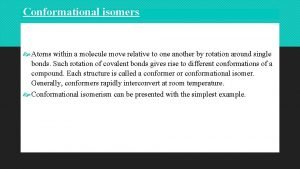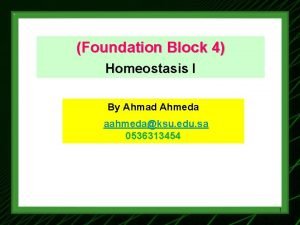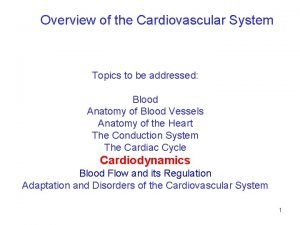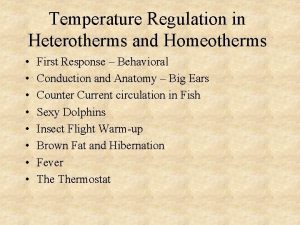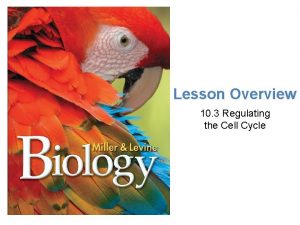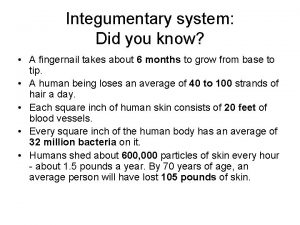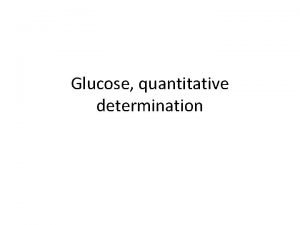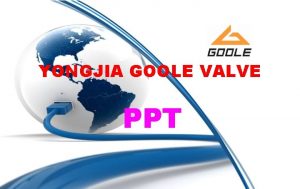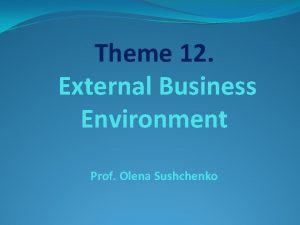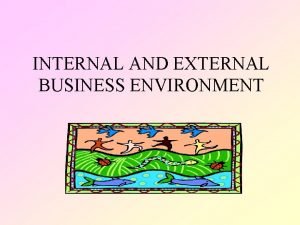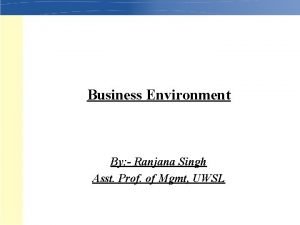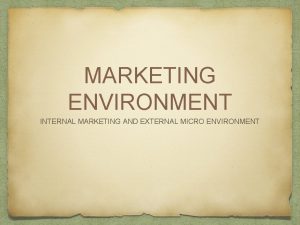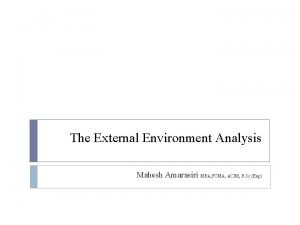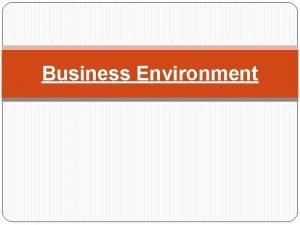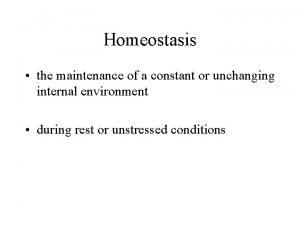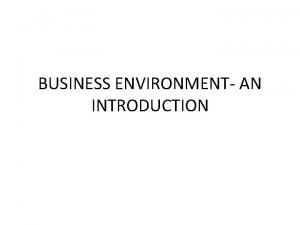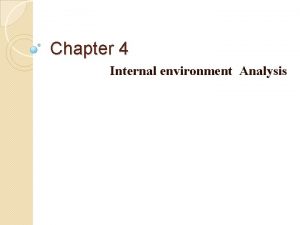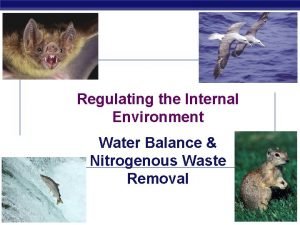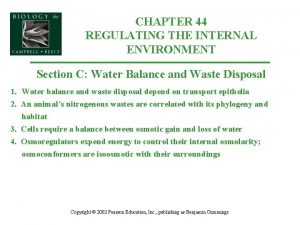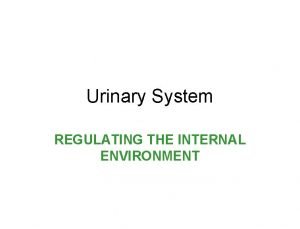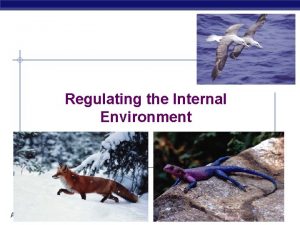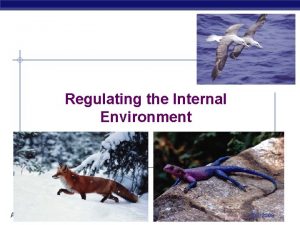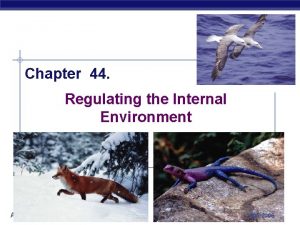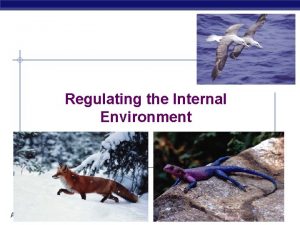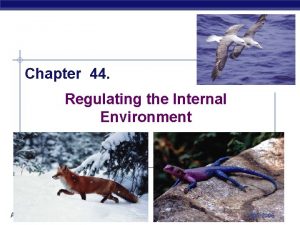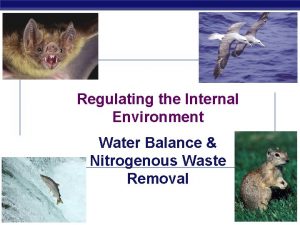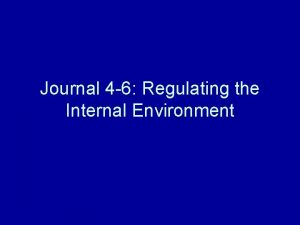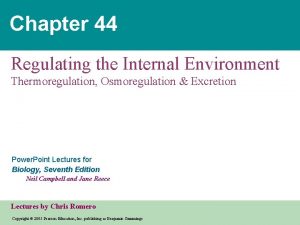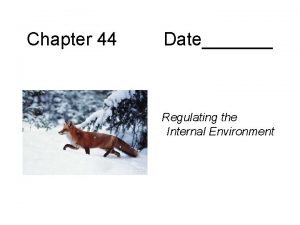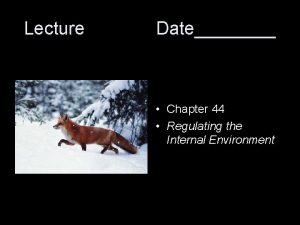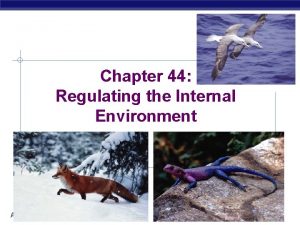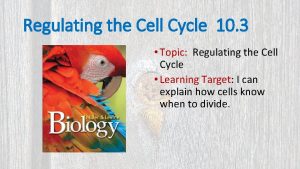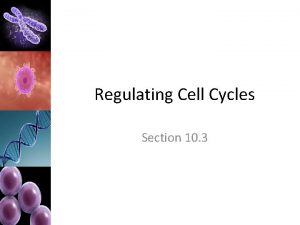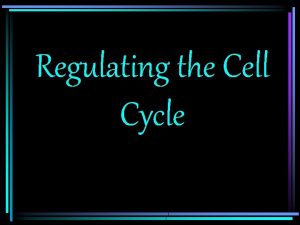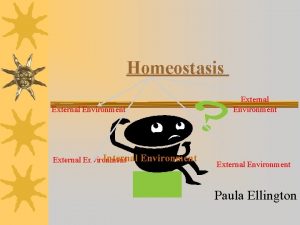Regulating the Internal Environment Ch 40 44 Conformers













































- Slides: 45

Regulating the Internal Environment (Ch. 40, 44)

Conformers vs. Regulators • Two evolutionary paths for organisms – regulate internal environment • maintain relatively constant internal conditions – conform to external environment • allow internal conditions to fluctuate along with external changes osmoregulation thermoregulation regulator conformer

Bioenergetics of an animal: an overview Organic molecules in food External environment Animal body Digestion and absorption Heat Nutrient molecules in body cells Carbon skeletons Cellular respiration Energy lost in feces Energy lost in urine Heat ATP Biosynthesis: growth, storage, and reproduction Heat Cellular work Heat

Homeostasis • Keeping the balance – animal body needs to coordinate many systems all at once • • temperature blood sugar levels energy production water balance & intracellular waste disposal nutrients ion balance cell growth – maintaining a “steady state” condition

Animal systems evolved to support multicellular life aa O 2 CH CHO CO 2 aa NH 3 CHO O 2 CH aa CO 2 aa aa CH NH 3 CO 2 NH 3 O 2 NH 3 CO 2 intracellular waste CO 2 NH 3 CO 2 aa CHO Diffusion too slow! extracellular waste

Overcoming limitations of diffusion • Evolution of exchange systems for – distributing nutrients • circulatory system – removing wastes • excretory system CO 2 aa CO 2 O 2 systems to support multicellular organisms aa CH NH 3 CO 2 NH 3 O 2 NH 3 CO 2 NH 3 CO 2 aa CHO

Maximum metabolic rates over different time spans Maximum metabolic rate (kcal/min; log scale) 500 A = 60 -kg alligator AH 100 A H H = 60 -kg human 50 H 10 H H 5 A 1 A 0. 5 0. 1 1 second 1 minute 1 hour Time interval Key Existing intracellular ATP from glycolysis ATP from aerobic respiration 1 day A 1 week

Energy budgets for four animals Annual energy expenditure (kcal/yr) Endotherms 800, 000 Reproduction Basal metabolic rate Ectotherm Temperature regulation costs Growth Activity costs 340, 000 8, 000 4, 000 60 -kg female human from temperate climate 4 -kg male Adélie penguin from Antarctica (brooding) (a) Total annual energy expenditures 0. 025 -kg female deer mouse from temperate North America 4 -kg female python from Australia Energy expenditure per unit mass (kcal/kg • day) 438 Human 233 Python Deer mouse (b) Energy expenditures per unit mass (kcal/kg • day) Adélie penguin 36. 5 5. 5

The relationship between body temperature and environmental temperature in an aquatic endotherm and ectotherm 40 Body temperature (°C) River otter (endotherm) 30 20 Largemouth bass (ectotherm) 10 0 10 20 30 Ambient (environmental) temperature (°C) 40

Heat exchange between an organism and its environment Radiation is the emission of electromagnetic waves by all objects warmer than absolute zero. Radiation can transfer heat between objects that are not in direct contact, as when a lizard absorbs heat radiating from the sun. Convection is the transfer of heat by the movement of air or liquid past a surface, as when a breeze contributes to heat loss from a lizard’s dry skin, or blood moves heat from the body core to the extremities. Evaporation is the removal of heat from the surface of a liquid that is losing some of its molecules as gas. Evaporation of water from a lizard’s moist surfaces that are exposed to the environment has a strong cooling effect. Conduction is the direct transfer of thermal motion (heat) between molecules of objects in direct contact with each other, as when a lizard sits on a hot rock.

Countercurrent heat exchangers 1 Canada goose Arteries carrying warm blood down the legs of a goose or the flippers of a dolphin are in close contact with veins conveying cool blood in the opposite direction, back toward the trunk of the body. This arrangement facilitates heat transfer from arteries to veins (black arrows) along the entire length of the blood vessels. 2 Artery Vein 1 35°C 33° 30º 27º 20º 18º 10º 9º 2 3 Near the end of the leg or flipper, where arterial blood has been cooled to far below the animal’s core temperature, the artery can still transfer heat to the even colder blood of an adjacent vein. The venous blood continues to absorb heat as it passes warmer and warmer arterial blood traveling in the opposite direction. Pacific bottlenose dolphin 1 3 Blood flow 3 Vein Artery 2 3 As the venous blood approaches the In the flippers of a dolphin, each artery is center of the body, it is almost as warm surrounded by several veins in a as the body core, minimizing the heat lost as a result of supplying blood to body parts countercurrent arrangement, allowing efficient heat exchange between arterial immersed in cold water. and venous blood.

Mammalian integumentary system Hair Epidermis Sweat pore Muscle Dermis Nerve Sweat gland Hypodermis Adipose tissue Blood vessels Oil gland Hair follicle

A terrestrial mammal bathing, an adaptation that enhances evaporative cooling

The thermostat function of the hypothalamus in human thermoregulation Sweat glands secrete sweat that evaporates, cooling the body. Thermostat in hypothalamus activates cooling mechanisms. Increased body temperature (such as when exercising or in hot surroundings) Blood vessels in skin dilate: capillaries fill with warm blood; heat radiates from skin surface. Body temperature decreases; thermostat shuts off cooling mechanisms. Homeostasis: Internal body temperature of approximately 36– 38 C Body temperature increases; thermostat shuts off warming mechanisms. Decreased body temperature (such as when in cold surroundings) Blood vessels in skin constrict, diverting blood from skin to deeper tissues and reducing heat loss from skin surface. Skeletal muscles rapidly contract, causing shivering, which generates heat. Thermostat in hypothalamus activates warming mechanisms.

Body temperature and metabolism during hibernation in Belding’s ground squirrels Additional metabolism that would be necessary to stay active in winter Temperature (°C) Metabolic rate (kcal per day) 200 100 Actual metabolism 0 35 30 25 Arousals Body temperature 20 15 10 5 0 -5 -10 -15 Outside temperature June August Burrow temperature October December February April

Osmoregulation hypotonic • Water balance – freshwater • hypotonic • water flow into cells & salt loss – saltwater • hypertonic • water loss from cells hypertonic – land • dry environment • need to conserve water • may also need to conserve salt Why do all land animals have to conserve water? § always lose water (breathing & waste) § may lose life while searching for water

Intracellular Waste • What waste products? Animals poison themselves from the inside by digesting proteins! – what do we digest our food into… • • CO 2 + H 2 O carbohydrates = CHO lipids = CHO CO 2 + H 2 O proteins = CHON CO 2 + H 2 O + N nucleic acids = CHOPN cellular digestion… cellular waste NH 2 = ammonia lots! very little CO 2 + H 2 O + P + N H| O || H N –C– C–OH | H R CO 2 + H 2 O

Nitrogenous waste disposal • Ammonia (NH 3) – very toxic • carcinogenic – very soluble • easily crosses membranes – must dilute it & get rid of it… fast! • How you get rid of nitrogenous wastes depends on – who you are (evolutionary relationship) – where you live (habitat) aquatic terrestrial egg layer

Nitrogen waste § Aquatic organisms u u can afford to lose water Ammonia: most toxic § Terrestrial u u need to conserve water Urea: less toxic § Terrestrial egg layers u u u need to conserve water need to protect embryo in egg uric acid: least toxic

Freshwater animals • Water removal & nitrogen waste disposal – remove surplus water • use surplus water to dilute ammonia & excrete it – need to excrete a lot of water so dilute ammonia & excrete it as very dilute urine • also diffuse ammonia continuously through gills or through any moist membrane – overcome loss of salts • reabsorb in kidneys or active transport across gills

Land animals H • Nitrogen waste disposal on land H H – need to conserve water – must process ammonia so less toxic N C N H • urea = larger molecule = less soluble = less toxic – 2 NH 2 + CO 2 = urea – produced in liver Urea – kidney costs energy to synthesize, but it’s worth it! • filter solutes out of blood • reabsorb H 2 O (+ any useful solutes) • excrete waste – urine = urea, salts, excess sugar & H 2 O » urine is very concentrated » concentrated NH 3 would be too toxic mammals O

Egg-laying land animals • Nitrogen waste disposal in egg – no place to get rid of waste in egg – need even less soluble molecule • uric acid = BIGGER = less soluble = less toxic – birds, reptiles, insects itty bitty living space!

Uric acid • Polymerized urea – large molecule – precipitates out of solution And that folks, is why most male birds don’t have a penis! • doesn’t harm embryo in egg – white dust in egg • adults still excrete N waste as white paste – no liquid waste – uric acid = white bird “poop”! O H H N N O O N N H H

Mammalian System • Filter solutes out of blood & reabsorb H 2 O + desirable solutes • Key functions blood filtrate – Filtration: fluids (water & solutes) filtered out of blood – Reabsorption: selectively reabsorb (diffusion) needed water + solutes back to blood – Secretion: pump out any other unwanted solutes to urine – Excretion: expel concentrated urine (N waste + solutes + toxins) from body concentrated urine

• What’s in blood? – Cells – Plasma • • • H 2 O = want to keep proteins = want to keep glucose = want to keep salts / ions = want to keep urea = want to excrete

Mammalian Kidney inferior vena cava aorta adrenal gland kidney nephron ureter bladder urethra renal vein & artery epithelial cells

Nephron § Functional units of kidney 1 million nephrons per kidney Function u filter out urea & other solutes (salt, sugar…) u blood plasma filtered into nephron § high pressure flow u selective reabsorption of valuable solutes & H 2 O back into bloodstream § greater flexibility & control u § why selective reabsorption & not selective filtration? “counter current exchange system”

Mammalian kidney • Interaction of circulatory & excretory systems • Circulatory system – glomerulus = ball of capillaries • Excretory system – nephron – Bowman’s capsule – loop of Henle • proximal tubule • descending limb • ascending limb • distal tubule – collecting duct Bowman’s capsule Proximal tubule Distal tubule Glomerulus Glucose Amino acids H 2 O Mg++ Ca++ H 2 O Na+ Cl. H 2 O Loop of Henle Collecting duct

Nephron: Filtration • At glomerulus – filtered out of blood • • H 2 O glucose salts / ions urea – not filtered out • cells • proteins high blood pressure in kidneys force to push (filter) H 2 O & solutes out of blood vessel BIG problems when you start out with high blood pressure in system hypertension = kidney damage

Nephron: Re-absorption • Proximal tubule – reabsorbed back into blood • Na. Cl – active transport of Na+ – Cl– follows by diffusion • H 2 O • glucose • HCO 3– bicarbonate – buffer for blood p. H

Nephron: Re-absorption § Loop of Henle u descending limb § high permeability to H 2 O w many aquaporins in cell membranes § low permeability to salt w few Na+ or Cl– channels u reabsorbed § H 2 O structure fits function!

Nephron: Re-absorption § Loop of Henle u ascending limb § low permeability to H 2 O § Cl- pump § Na+ follows by diffusion w different membrane proteins u reabsorbed § salts w maintains osmotic gradient structure fits function!

Nephron: Re-absorption § Distal tubule u reabsorbed § salts § H 2 O § HCO 3 w bicarbonate

Nephron: Reabsorption & Excretion § Collecting duct u reabsorbed § H 2 O u excretion § concentrated urine passed to bladder w impermeable lining

Osmotic control in nephron • How is all this re-absorption achieved? – tight osmotic control to reduce the energy cost of excretion – use diffusion instead of active transport wherever possible the value of a counter current exchange system

Summary • Not filtered out – Cells, proteins – remain in blood (too big) why selective reabsorption & not selective filtration? • Reabsorbed: active transport – Na+ Cl-, amino acids, glucose • Reabsorbed: diffusion – Na+, Cl–, H 2 O • Excreted – Urea, excess H 2 O, excess solutes (glucose, salts), toxins, drugs, “unknowns”

Negative Feedback Loop hormone or nerve signal lowers body condition gland or nervous system (return to set point) high sensor specific body condition sensor raises body condition low gland or nervous system (return to set point) hormone or nerve signal

Nervous System Controlling Body Temperature nerve signals brain sweat high body temperature low brain constricts surface shiver blood vessels nerve signals dilates surface blood vessels

Endocrine System Control Blood Osmolarity ADH pituitary increased water reabsorption increase thirst nephron high blood osmolarity blood pressure low ADH = Anti. Diuretic Hormone

Maintaining Water Balance • High blood osmolarity level Get more water into blood fast – too many solutes in blood • dehydration, high salt diet – stimulates thirst = drink more – release ADH from pituitary gland • antidiuretic hormone – increases permeability of collecting duct & reabsorption of water in kidneys • increase water absorption back into blood • decrease urination Alcohol suppresses ADH… makes you urinate a lot! H 2 O

Endocrine System Control Blood Osmolarity Oooooh, zymogen! JGA = Juxta. Glomerular Apparatus high blood osmolarity blood pressure adrenal gland increased water & salt reabsorption in kidney low JGA nephron renin aldosterone angiotensinogen

Maintaining Water Balance • Low blood osmolarity level or low blood pressure Get more water & salt into blood fast! – JGA releases renin in kidney – renin converts angiotensinogen to angiotensin – angiotensin causes arterioles to constrict • increase blood pressure – angiotensin triggers release of aldosterone from adrenal gland – increases reabsorption of Na. Cl & H 2 O in kidneys • puts more water & salts back in blood Why such a rapid response system? Spring a leak? adrenal gland

Endocrine System Control Blood Osmolarity ADH increased water reabsorption pituitary nephron high blood osmolarity blood pressure adrenal gland increase thirst increased water & salt reabsorption low Juxta. Glomerular Apparatus nephron renin aldosterone angiotensinogen

Don’t get batty… Ask Questions!!

Make sure you can do the following: 1. Label/Identify all organs that play major roles in the Excretory system. 2. Diagram all important parts of a nephron and explain their functions. 3. Diagram the feedback loops that function in regulating blood osmolarity. 4. Compare and contrast thermoregulatory strategies of endoderms and ectoderms 5. Explain the causes of excretory system disruptions and how disruptions of the excretory system can lead to disruptions of homeostasis.
 Conformational isomers
Conformational isomers Regulating body temperature
Regulating body temperature Factors affecting stroke volume
Factors affecting stroke volume Piloerection
Piloerection Understanding the management process
Understanding the management process Cell cycle
Cell cycle Regulating body temperature
Regulating body temperature 10-3 regulating the cell cycle
10-3 regulating the cell cycle Regulating blood glucose
Regulating blood glucose Igoole
Igoole Financial environment of business
Financial environment of business Internal environment of an organization
Internal environment of an organization Assessing the internal environment of the firm
Assessing the internal environment of the firm Internal business environment factors
Internal business environment factors Internal and external business environment
Internal and external business environment Components of internal business environment
Components of internal business environment Internal marketing environment
Internal marketing environment Components of internal environment
Components of internal environment What are the objectives of business environment
What are the objectives of business environment Internal and external environment of the school system
Internal and external environment of the school system Maintenance of a constant internal environment
Maintenance of a constant internal environment Internal environment factors
Internal environment factors Technological environment in business
Technological environment in business Maintenance of a relatively stable internal environment
Maintenance of a relatively stable internal environment Internal control structure
Internal control structure Audit report of a company
Audit report of a company độ dài liên kết
độ dài liên kết Môn thể thao bắt đầu bằng từ đua
Môn thể thao bắt đầu bằng từ đua Khi nào hổ mẹ dạy hổ con săn mồi
Khi nào hổ mẹ dạy hổ con săn mồi điện thế nghỉ
điện thế nghỉ Một số thể thơ truyền thống
Một số thể thơ truyền thống Nguyên nhân của sự mỏi cơ sinh 8
Nguyên nhân của sự mỏi cơ sinh 8 Trời xanh đây là của chúng ta thể thơ
Trời xanh đây là của chúng ta thể thơ Voi kéo gỗ như thế nào
Voi kéo gỗ như thế nào Lp html
Lp html Thế nào là số nguyên tố
Thế nào là số nguyên tố Thiếu nhi thế giới liên hoan
Thiếu nhi thế giới liên hoan Vẽ hình chiếu vuông góc của vật thể sau
Vẽ hình chiếu vuông góc của vật thể sau Các châu lục và đại dương trên thế giới
Các châu lục và đại dương trên thế giới Thế nào là hệ số cao nhất
Thế nào là hệ số cao nhất Hệ hô hấp
Hệ hô hấp Tư thế ngồi viết
Tư thế ngồi viết đặc điểm cơ thể của người tối cổ
đặc điểm cơ thể của người tối cổ Mật thư anh em như thể tay chân
Mật thư anh em như thể tay chân Bổ thể
Bổ thể Thang điểm glasgow
Thang điểm glasgow
